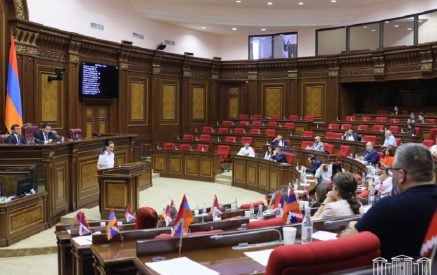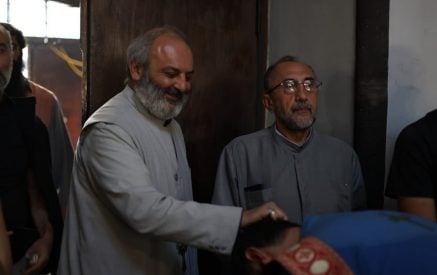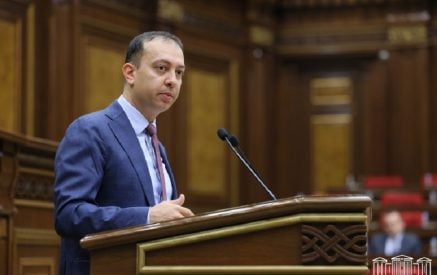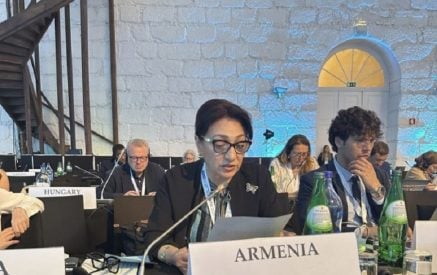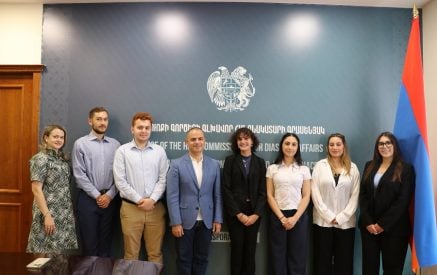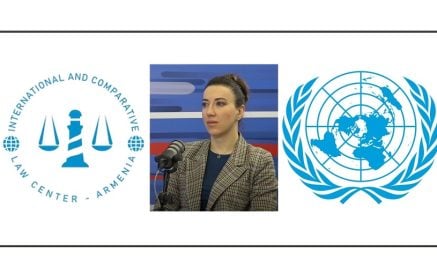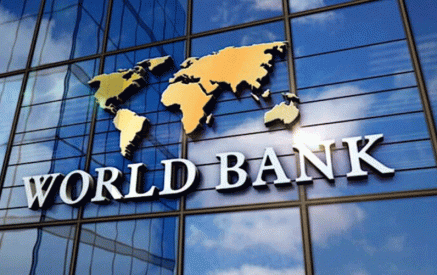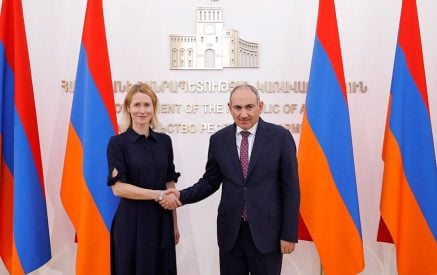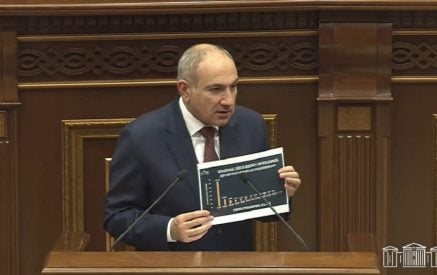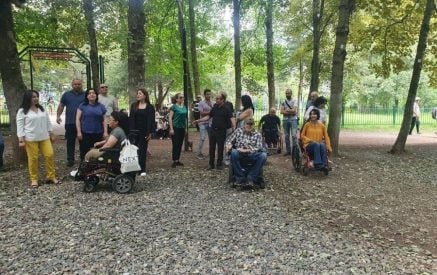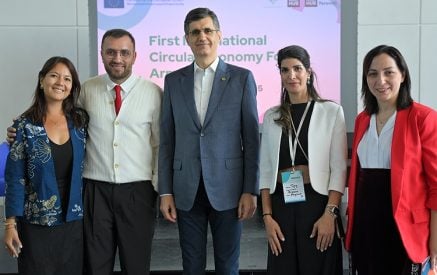My first observation is that there is an inconsistency between the Program and the Prime Minister\’s speech on the Program. Priorities declared in the speech were not correspondingly covered in the Program. Namely, it is not clear from the Program how the Government would make our national security and sustainable development safer. No direct and specific steps are set out.
In particular, the issue of Artsakh is the cornerstone of our national security, and unfortunately Turkey also becomes an issue of national security. This is the most critical point. In light of the amended Constitution, these essential points should have been reflected in the Government Program, rather than a reference being made to a national security document which is confidential, not published and not submitted to Parliament for discussion.
The Program lacks a uniform concept of reform sustainability. A number of measures, which are of course in the spirit of the development of the market economy, are more episodic and eclectic in nature. The ultimate objective is not clear, and the steps lack coherence. Some phenomena, where there are things to be said, are described in full detail (e.g. poverty reduction issues), while others are very general (e.g. foreign economic policy, cultural, youth and sports issues, etc.). Many issues and respectively steps for addressing them arise from an incorrect statistical and information base. There is a need for serious further reviews. However, adopting a five-year program is at any rate a positive phenomenon, and its development is of course a grateful job. Here are more specific comments on individual provisions of the program.
1. The Government intends to continue activities aimed at creation of inter-community unions (4.2.2). This point obviously contradicts the statement about addressing regional disparities in development expressed earlier. Of course, 47.3% of industrial production, 84.2 % of construction, 82.6 % of trade and 84.8% of services (2005) in Armenia is concentrated in Yerevan. For comparison it should be noted that this trend exists in other countries as well, but it is more moderate there. For instance, 49.3% of goods turnover and 65.9% of services is concentrated in Baku. In Tbilisi, these figures equal to 48-50%. As experience shows, enlargement of villages in the 60-s of the last century led to abandoning of highly mountainous and remote areas. I have doubts that the large-scale implementation of inter-community unions will lead to the same result. From the first glance it appears that this is merely a more reliable medium of self-sufficiency. It might as well be. However, I don\’t think it is feasible that serious normative activities will be implemented. Movement of the population to community centers might be more efficient. This is why it would be right to address the issue of sustainability (economic, financial, self-governance, etc) at local level by improving arrangements for reasonably centralized reallocation of public resources.
2. Inflation in Armenia was low compared to its neighbors in recent years. In 2005 officially reported inflation was 0.6% in Armenia, 8.2% in Georgia, 5.4 % in Azerbaijan, 8.2% in Turkey and 13.4% in Iran. In the meantime, the state budget deficit in these countries was approximately at the same level (-2%, -1.8%, -1.7%, -1.4% respectively and in Iran there was a surplus of 7.4%) and the BOP deficit to GDP in Armenia was the highest (31%). However, we are the only country that preferred not to have inflation. Russia and Iran, for example, had a huge BOP and budget surplus, but they did not avoid inflation (7-10 % annually); they understand that structural economic changes, efficient reallocation of initial revenues, etc. are only possible at a certain level of inflation. Under these circumstances how justified it is that Armenia is the only country in the region and in CIS, where CBA uses only one (inflation) of its three main targets (inflation, exchange rate and interest rates). This is done at the expense of dram appreciation which is supposedly explained by remittances of about 1.5 billion dollars. In reality there are not such remittances and appreciation cannot be explained by it (what about Azerbaijan, where remittances are twice as much as in Armenia plus around 3 billion left from oil) . The truth is that only by targeting inflation (this point was even included in the Constitution, perhaps this is the only case in the world) the CBA puts all the problems of the economy on the shoulders of the Government and the banks in a privileged situation. The payers are the Government, the systematic decline in export amounts (if the impact of inflation and increase in world prices is neutralized, export volumes during the last ten years increased by 80%, whereas GDP was doubled, i.e. there is a trend of stable relative decline in export volumes). Imported juices and cooked meats are sometimes cheaper than those produced locally. There is one solution: the CBA should share its targets between the objectives of inflation and dram exchange rate stabilization.
3. The subsection on combating corruption consists of declarative statements: it is not clear what specific steps the Government should take to reduce corruption risks. Isn\’t the merger of power and ownership, entrepreneurship and public governance a corruption risk? 85 members of parliament are large businessmen. The majority of ministers (health, transport and communication, agriculture) are large shareholders in given sectors. Aren\’t these the biggest corruption risks?
4. It is stated in the Program, that economic growth in 2001-2006 (13% on average) was among the highest in the world. This is not true. Every year we are facing outright falsification of statistical numbers (a specific mechanism of playing with numbers is illustrated on the specific example of grapes). We are ashamed of showing 10% less growth. We should pay attention to the fact that the sectors of agriculture, services and construction were reportedly the drivers of growth in 2000-2006. These are those sectors, where there are statistical manipulations in form of “estimations”. If we trust the growth number, according to the same official statistics GDP in 2005 amounted to 119.7% and agriculture to 192% of the 1990 level, etc. In this period the population declined by 25%: Real income in 2005, however, accounted only for 14%, retail trade for 59.6% and services 50.5% of the level of 1990. Nobody has explained so far, how this could have happened. Either there is no growth, or the situation is poor in the trade and services sector. And here again, what drove the overall growth, if one of the main components of growth, the services sector, did not grow (compared to 1990). This is the Achilles\’ heel of our statistics. Although this issue was raised with the statistical authorities several times, no answer was received. I assume that economic growth in 2000-2006 was 5-8 % per annum. The rest was added for political and economic purposes. Another statistical Achilles\’ heel was invented by the CBA: the remittances of 1.35-1.7 billion drams. In reality we are talking about 400-700 million dollars (see the data from the Russian Bank and public services of the Russian Federation). This 1 billion spent in part for financing the balance of payments and in part for acquisition of goods of services generated by the growth which did not happen, gives a rough idea about the extent of statistical exaggerations. Publishing of exaggerated data on remittances only allowed adding extra 3-4% to growth annually.
5. I think that the Government should put employment statistics and numbers in order, etc. According to official data the employment figure in absolute terms declined from 1.5 million people to 1.1 million. This is happening despite the fact that 40 thousand, and 100 thousand new jobs were promised before each election. In fact employment during the years of double-digit economic growth declined by 27%. This is of course a paradox. Given that GDP doubled during the same period, it would mean that labor productivity in Armenia grew by 2.54 times in the period between1998-2005. A complete nonsense. It is a wonderful idea to create 105 thousand new jobs as set out in the Government program. However, given the continued decline in the number of economically active population, and since the Government is trying to improve the living standards of the population through the same program, and the average life expectancy (which would mean a further aging of population), we might ask, where will they get the 105 thousand. The answer, which sounds logical from the first glance, about the army of the unemployed, is not relevant for the above-mentioned reason. We can only assume that the level of unemployment is in reality much higher, than the officially published 9%. Only in this case it would be possible to find the mentioned 105 thousand people and then provide jobs for them (there is also another option – perhaps it is assumed that once the borders are opened a large number employees of Turkish or Azerbaijani decent will penetrate into Armenia). Otherwise, if official statistics on employment and unemployment are accurate, I would recommend creating only 30-40 thousand jobs. In this case we will have 60-65 thousand unemployed, which is extremely important in order not to undermine the labor market. With zero unemployment there is no market, no labor quality and no change.
6. The Government indicates the increase in investments based on public-private partnerships (setting a threshold at 24-30% of GDP is absolutely right, among 5 countries in the region Armenia has today the lowest gross investment to GDP ratio). Of course the situation improves slowly and hence now one can make investments. Private-public partnership system is also interesting. However, it is not enough to just make a passing remark on this important issue. Here the Government should have mentioned about the priorities of economic development. Otherwise, it is not clear why we need such partnerships, which might increase corruption risks (while earlier they talked about reducing them).
7. One can but commend the idea to make Armenia the financial center in the region. This idea was first expressed in May 1992, when Armenia\’s strategy for economic policy was being drafted. Here, however, the problem is the CBA. From June 1996 Armenia pursued a policy of having a Central Bank implementing entire supervisory functions. To be sure, it would suffice to look at the normative base. By laws and the Constitution we put CBA above the state. Do the people who wrote the Program mean that we will further change the Constitution?
8. The section on agriculture is of concern. I think the reason for not being successful is that the statistics for this sector is significantly different from the reality. It is impossible to keep the statistics of 300,000 farms which came into existence from land privatization by the general method. Usually sampling statistics is arranged for fee. This was more or less recognized in Armenia up to 1997-1998, when sampling research was done systematically. From 1999 these activities were stopped. Agricultural statistics became the responsibility of the Ministry of Agriculture. For example, how is the statistics of crop production collected? Heads of villages report to regional governor\’s office data on the volume of types of products and land. The latter reports to the relevant department in the Ministry of Agriculture and the department reports to the National Statistics Service. As a result, the production volumes of the last 9 years were systematically inflated. Statistical interpretation of a number of products and particularly grape production volumes are doubled: production of 80-90 thousand tons is presented as 160-180 thousand tons. Together with the management of the statistical service and the Ministry of Agriculture, random checks were performed. It was established that land figures were 30-40% and crop yield – 50-60% higher than in reality. The result is double inaccuracy. After a few visits to these villages heads of the mentioned agencies refused to continue the checks. Particularly when I gave them satellite photographs (where the computer determines the area) and they had no such technology, it was becoming impossible to reach them by phone. Soon it emerged that all village heads have approved ratios from regional governors not only for grape but also for other products: 1.7 or 1.9 or 2.1, etc. For example 800 tons of grape is produced, but the head of the village reports 1,360 (800×1.7), 1000 tons of wheat, while 1900 tons is reported (1000×1.9). As a result, in 2005 gross agricultural output doubled compared to 1990. It might seem to be the most desirable outcome for me. As the main advocate and initiator of land privatization I can reproach my opponents (most of them are among the current authorities). Finally the last doubling of gross agricultural output in Armenia required 29 years (at comparable prices of 1973, 430 million rubles of 1961 amounted to 910 million in 1990), while now 15 years. I could have joined celebration of the success.
Harvesting is the problem. Officially the Ministry of Agriculture reported that 80 thousand tons of grape was harvested, whereas in fact it was only 40 thousand tons. Avshar, MAP, Ararat (Noy) wine, vodka and brandy, and Artashat Wincon factories harvest 1.5-3 thousand tons, but it is reported 6.7-15 thousand. Proportionate additions are made in more than a dozen other factories. Finally 40 thousand tons of grapes are added at 12 million dollars. The Minister of Agriculture was informed about it and was told that physical volumes of waste in enterprises harvesting grape and other agri-products should be officially handed over to representatives of the tax inspectorate. Nothing is done. Last time, the respectful former prime-minister A. Margaryan personally inquired about the problem and promised to solve it in 2007. Only the 12 million accounts for 0.12% of tax revenues.
9. In 2009, if I am not mistaken related with Armenia\’s joining of WTO, Armenia shall impose a tax on agri-products. Surprisingly enough this point was not included in the Program.
10. It is also worth mentioning that supposedly the “methodology” of agricultural statistics has been largely applied to construction and services sectors in 2001-2003. Do you see that the growing sectors are those, where ministries and regional governor offices collect estimated statistics? The statistics service is only assigned the role of a “statistician”.
11. The detailed coverage of irrigation in the program and state support for it is commendable. Unfortunately it talks about such arrangements which cannot lead to the desired outcome. Currently villagers are the slaves of the irrigation system and despite the Water Code, existence of legal documents on Water Users Associations (WUA) they are not able to combat the arbitrary behavior of the latter. All points discussed in the Program refer to the development of the irrigation system. Another issue is involved here: the costs will slump sharply, if farmers are subsidized instead of WUA-s. In this case the latter will \’run\’ after the villagers.
12. Pensions should not be immediately increased by 60% from January. They should be increased gradually, during the year. In general experience shows that a good pension system leads to a decrease in birth rate: people should know that in case of incapacity to work they would not survive without the children. Pensions should of course be increased, but more emphasis should be put on creating incentives for child benefits and higher birth rate. Armenia-specific feature in the coming years is that people should feel their secured existence economically not only by high pensions, but also a larger number of children.
13. A critical issue is the increase in tax -to-GDP ratio. The shadow economy has grown significantly in recent years. GDP increment was 90%. The increase in taxes was 95%. If we take into account the fact that CPI accounted for 14.9 % in this period, the increase in taxes should at least equal 117%. In general 1% increase in GDP should be followed by a 3% increase in taxes. For instance in 1994-1996 1% GDP growth was followed by 16% increase in taxes. In this sense increasing tax to GDP ratio by 0.3-0.4 % per annum under deepening shadow economy is equal to not combating the shadow economy. Moreover, small and medium-sized enterprises today (excluding farms) account for 26% of GDP (this number does not include the enterprises controlled by oligarchs), but provide 55% of taxes. Thus the shadow economy becomes more and more centralized in the hands of oligarchs. And hence growing by 0.3-0.4% in dynamics will not give anything to us: the shadow economy will further grow. Calculations show that the tax to GDP ratio should increase at least 1.6% per annum.
14. Two income tax schedules should be introduced in Armenia. One should be flat (say 10% up to 100,000 drams, 15% up to 1,000,000 drams) and progressive – 17% for the income above 1,000,000. The same applies to profit tax: a simplified tax to a certain threshold, 17.5% up to 1 million dollars in profit and 20 percent for the profit higher than 1 million. It is important that the average profit tax indicator be (1)18.5-19% and the income tax be slightly lower than the profit tax. In this case the progressive income tax will work, since the profit is determined after calculation of salaries and the income tax. Finally the practice of prepayments of profit tax should be ruled out.
15. In 1997-2001 in Armenia a “three-dimensional\’ tax system was formed: simplified, presumptive and \’regular\’ taxpayer. With the mentioned tax system reform a uniform tax territory should be established in Armenia.
16. Creating an efficient governance system is of course related to solution of a number of problems and issues. However, salaries remain the main issue. Recently, public sector salaries for managerial positions have grown at high rates in the West. First of all differentiation is introduced (general manager = minister, deputy, managers = department heads, division heads, staff and support staff). This helps to specify and alleviate the problem. Secondly, high managerial staff positions (general managers and managers) are paid equal to and even higher than the comparable staff positions in the private sector. Thirdly, the managerial staff salaries are significantly (from several times to several dozen times) higher than that of the staff and support staff. As a result, senior managerial staff has marginal incentives for abuse, money extortion and bribery.
17. Thoughts about the quality of the customs service are declarative. Ultimately, the main goal in the customs service is to set export and import prices. For the remaining issues the existing Customs Code is simply ideal. However, it is the very right to set prices, which breathes new life into the subjectivity of the customs staff. Finally, these prices should be either set (approved) by the state or the declared invoice prices should be accepted as a basis. In latter case it would be necessary to regulate the requirements set forth in law for invoices. I would recommend considering establishing of an alternative customs service in parallel.
18. In 2003 part of MP-s tried to introduce a special law on lotteries. The show by different actors started; it is a game, let us play. In general all types of lotteries, book-maker offices, bets should be state-owned (for example, Veikkaus company in Finland, which administers all lotteries, the National lottery in the Great Britain and a similar company in Italy. In the US it is also state-owned) or be managed by the paternalistic principle (the lottery is state-owned, but is managed by a private firm with fixed profit) or be managed by quasi-state bodies. Strangely enough, lottery regulation is completely missing in the budget and tax sections of the Program.
19. It is necessary that the excise tax on vodka be significantly higher than on wine. Currently it is still higher, but the difference should be such as to make wine production significantly more profitable. This way Armenia will use its advantage of having high quality and high crop yield (which is 4 times higher than in Georgia and 2 times higher than in France).
20. It is important to tax construction (taxation differentiated by location should be imposed ). There is no word on in it in the Program.
21. The Health Section is declarative. The problem of the sector is the lack of reforms. State funding with the parallel for fee services has become the monopoly of the people close to authorities. IT is important to understand the health sector has a structural problem and it is important to implement two mandatory and parallel steps. Firstly, the state finances not the health institution, but a person. The latter makes the payment. Secondly, medical insurance should be introduced, mandatory for the part financed by the state and voluntary for medical care not financed by the state.
22. Naturally the Government pays attention to IT development. It is mentioned several times. This is where Armenia\’s comparative advantages should have been demonstrated. It has been several years now that the sector was announced as a priority. And yet, at first 90 % of the telecommunications sector was sold to a Greek company as a monopoly. It should be mentioned that this was nationalization rather than privatization (OTE is a state-owned company). Later it was sold to a Russian company. Russians, as the Greek, play a role of third importance in the telecommunication technology. Moreover, Russians were also granted the remaining 10%. As a result, currently the number of land line and mobile phones per 1000 population in Armenia is 260, in Georgia 337, in Azerbaijan 397, in Iran 384, and in Turkey 868. In terms of the use of internet Armenia is the fifth (53 out of 1000 people) among these 5 countries (the situation is similar only in Georgia). Thus, 5 years ago two presidents (Armenia and Georgia) announced about the development of the telecommunication technologies. Armenia is currently 2 times behind Azerbaijan, and ranks the worst in the region. It is unfortunate, since here we have put ourselves in a blockade. How does the Government intend to correct the situation and what steps to take? Such questions are neither answered nor addressed.
23. The Government\’s stance on science remains totally unclear. In the Education section it is mentioned about the need to cover science in Education. Then it is mentioned that the place and role of the National Academy of Sciences (NAS), arrangements for ensuring the competitiveness and efficiency of Scientific and Research Institutes and their reconciliation is planned to be clarified,. These words, in their full sense, have been repeatedly said since the XXIV Assembly of CPSU. Any change in the science sector would be possible if two significant problems are solved: (1) the topic rather than scientific or educational establishment is financed from the budget and (2) Presidency of the NAS is a merely non-governmental deliberative body, which has no institutes, does not give out money or assign staff.
24. The sections on Culture, Physical Culture and Sports, Young People, Diaspora, Migration, Defense, Public Order and Security are not successful. They are declarative phrases and if we change the date and place they would match any society (socialist, capitalist or communist) and any people (except for the subsection on Diaspora).







